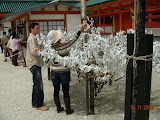Our tour guide, Junko-san, carried a flag so we could see where she was in the crowds, but she was so little that we lost sight of her frequently. Our first stop was the
Of note at this temple was a shrine for lost babies, with many small Buddha statues without faces, decorated with red aprons. Mothers come here to look for the face of their dead
children and pray for their happiness. (Prior to WWII, village-mandated abortion was one of the primary birth control methods in
There were many charms for sale, promising good luck for specific events – happy marriage, healthy baby, good results on exams. You can purchase a paper fortune at a booth – if you like the fortune, you bring it home with you; if you do not like the fortune, you hang it on a tree for the winds to carry away…
Back on the bus (at exactly 11 o’clock – we were terribly punctual all day!) we ventured next to Heian Shinto Shrine. Here the style of praying was a bit different – after placing money at the shrine, the supplicant bows twice with hands in prayer position, then claps twice to get the
attention of the gods, then bows again.
Our next stop was
castle consisted of outer rooms constructed for lords waiting to see the shogun, and inner chambers where the shogun and his maidservants slept. We had to take off our shoes to tour the castle, and noted that the wooden floors surrounding the outer chambers were constructed to make a squeaking sound at the slightest footfall. The floors are called “nightingale floors” as the sound of a person walking sounds like a bird call, to alert the people within of any intruders. The castle was surrounded by a moat, and had beautiful gardens with rockery and water features all around it.
Our last experience of the day was Kinkaku-ji, or the Golden Pavilion, which was constructed in the 1390s as a retirement villa for the shogun. The building is entirely covered in gold leaf, and is a sight to behold across the water. We were not permitted to go inside this building, but were informed that George W. did so during his visit to Japan. The pavilion is surrounded by beautiful gardens, and here we observed several women dressed in traditional kimonos, having their pictures taken in the gardens.
Nowadays, women only wear the kimono, which is very tight and severely restricts movement, for weddings and special occasions like tea ceremonies. The kimono is impossible to put on by oneself, so there are shops that one can go to with people who will help you don the kimono properly.
The exchange rate here is about 100 yen = 1 US dollar, so it was pretty easy to mentally convert the prices. The Japanese do not bargain – the price is the price. Although we were aware that things were expensive here, due to the weakness of the dollar, they were not as bad as we anticipated, and we were able to purchase souvenirs. My son David asked for Japanese candy as a souvenir – many sweets here are made of rice paste and do not travel well – I hope we got a kind that he likes!








No comments:
Post a Comment